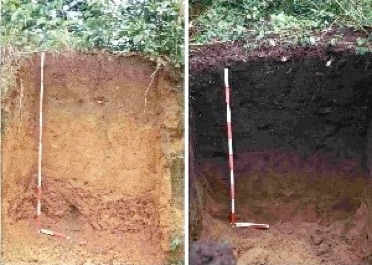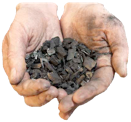training - consulting - facilitating

get answers to some common questions


Biochar
Biochar is the name for charcoal produced through a process called pyrolysis. Pyrolysis is the process of heating organic material (biomass) to high temperatures in a low oxygen atmosphere. This chemically and physically transforms the biomass carbon into a form that is stable for potentially hundreds to thousands of years.
Biochar can be made from any biomass, such as wood, manure, food waste, organic byproducts, bioenergy crops, crop residues or any other organic material. The nutritional qualities, absorption capacity, cation exchange capacity and degradation time of biochar will depend on the type of biomass fed into the pyrolysis process and the pyrolysis management (e.g. temperature, pressure and time).
The stability of biochar means it has a potential carbon sequestration value. Carbon sequestration (in the simplest use of the term) means the capture of atmospheric carbon dioxide (CO2) and it’s storage in a ‘carbon sink’. A carbon sink is any natural or artificial long-term reservoir for the carbon.
Biochar and greenhouse gas emissions
Pyrolysis of biomass into biochar ensures that CO2 captured from the atmosphere by photosynthesis (during biomass growth) does not re-enter the atmosphere as quickly as it would if allowed to naturally decompose.
Biochar can meet the ‘100 year rule’ in removing CO2 from the atmosphere. The ‘100 year rule’ is an agreed timescale carbon must reside in a carbon sink for it to be counted under general international carbon accounting rules. Conversion to biochar also prevents emission of the greenhouse gas (GHG) methane (CH4) during natural biomass decomposition.
Biochar could play an important role as a carbon sink. Biomass contains carbon dioxide captured from the atmosphere during growth and transforming it by pyrolysis locks the carbon into a charcoal form for a long time. This equals a net decrease of carbon dioxide in the atmosphere, or ‘carbon sequestration’.
When biomass decomposes naturally it also emits quantities of the GHG methane (CH4) that has a global warming potential (GWP) of approximately 23 times that of CO2.
answers to some frequently asked questions about Biochar
to find out more - simply click on the icon links on these pages or click documents to download the files
find out more about biochar science by
The 100 year rule was established by the UNFCCC
biochar


Depending on biomass inputs, moisture content, temperature, pressure and time, the pyrolysis process can yield a diverse range of substances. Biomass yields gas and liquid products, leaving behind a solid residue rich in carbon. When pyrolysis is conducted on various biomass sources in the 400-700°C range, approximately 50% of the biomass is recovered as biochar with most of the rest recovered as volatile ‘synthesis’ gases (syngas). Extreme pyrolysis at higher temperatures and time leaves more of the biomass in the carbon enriched residue - a process termed ‘carbonisation’. Syngas can be recovered and used for bioenergy utilisation (heat and power). Syngas can be fed back into the pyrolysis management process or captured for off-site applications. Pyrolysis is heavily used in the chemical manufacturing industries to transform organic molecules.
All biochars are not the same and their long-term degradation time is difficult to determine. Although studies on charcoal caused by past natural fire events and human activities indicates potential stability on a millennial scale, this property is difficult to validate for modern biochar products due to the lack of standard artificial ageing methods that enable comparative modelling.
Biochar in soils
‘Terra preta’ (‘black earth’ in Portuguese) is a dark and fertile soil found in the Amazon Basin that was created by Amazonian Indian people mixing charcoal, bone and manure into the soil. These sites may range from hundreds to thousands of year in age and are more fertile for crop growth than surrounding soils.
Research has shown that adding biochar to soils has a variety of beneficial effects, including:
-
•increasing soil carbon
-
•increasing biomass production
-
•decreasing soil acidity (pH adjustment)
-
•improving soil structure
-
•decreasing bulk density
-
•increasing nutrient use efficiency
-
•increasing cation exchange capacity
-
•improving water-holding capacity
-
•absorption of toxins in contaminated soil
-
•decreasing the release of carbon dioxide (CO2), methane (CH4) and nitrous oxide (N2O)
These benefits can lead to improved agricultural soil productivity if the correct type of biochar is used at an appropriate rate to address a soil health issue. Soils can vary significantly in their chemical, physical and soil biology characteristics and will respond differently to biochar types and addition rates. Care is required to avoid biochar additions having a negative effect on soil characteristics and productivity.
Studies reporting positive effects of biochar addition with regard to crop production have often involved highly degraded and nutrient-poor soils, whereas application of biochar to fertile and healthy soils does not always yield a positive improvement. The absorptive capacity of biochar may irreversibly bind essential crop nutrients in the soil, reducing their availability to plants.
Research needs
There are substantial knowledge gaps requiring further research to ensure safe biochar production and use. Scaling the results of small scale research trials conducted to date indicate a global potential for annual sequestration of atmospheric CO2 in the billion-tonne scale (109 t yr-1) within the next 30 years.
However, questions remain about the safety levels of some combustion byproducts and contaminants and their potential impacts of terrestrial and aquatic ecosystems. The safety risks in transport and distribution of the hazardous biochar products also requires further consideration. Initial beneficial effects on soils and crop productivity through addition of biochar may change to adverse effects on surrounding ecosystems if biochar is over-applied.
The bio-physical effects and interactions of biochar application in agronomic systems are not well understood and there is a need to examine these across a range of biochar types, soil types, climates and cropping systems.
The costs of biochar production and emerging carbon markets, energy markets and policy environments will all impact on biochar economics. Uncertainty in these parameters may restrict investment in biochar development.
Further information
For more information about current biochar research projects visit:
Australia and New Zealand Biochar Researchers Network
Visit the CSIRO website for fact sheets about biochar

Left shows the profile of a naturally nutrient-poor soil. Right is the profile of a fertile soil that was transformed using biochar - a ‘terra preta’


Assessing the full carbon sequestration benefit will require analysis of all the carbon storage gains and losses throughout the biochar lifecycle from production, transport and application to physical and chemical changes to the soil it is applied to, over time.
Pyrolysis
Pyrolysis is the combustion of biomass in low oxygen atmospheres. In practice, it is difficult to completely remove oxygen from the process and some small oxidation occurs. Pyrolysis of carbohydrates can begin above temperatures of 100°C when there is no free water.

© 2019 Frontline Services Australia Pty Ltd | ABN 41 136 738 997 ACN 136 738 997 | E: info@frontlineservices.com.au
